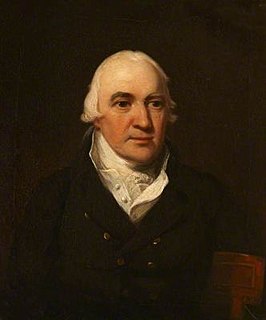Labour laws are those that mediate the relationship between workers, employing entities, trade unions and the government. Collective labour law relates to the tripartite relationship between employee, employer and union. Individual labour law concerns employees' rights at work also through the contract for work. Employment standards are social norms for the minimum socially acceptable conditions under which employees or contractors are allowed to work. Government agencies enforce labour law.

Anthony Ashley Cooper, 7th Earl of Shaftesbury,, styled Lord Ashley from 1811 to 1851, was a British politician, philanthropist and social reformer. He was the eldest son of The 6th Earl of Shaftesbury and his wife, Lady Anne Spencer, daughter of The 4th Duke of Marlborough, and older brother of Henry Ashley, MP. As a social reformer who was called the "Poor Man's Earl", he campaigned for better working conditions, reform to lunacy laws, education and the limitation of child labour. He was also an early supporter of the Zionist movement and the YMCA and a leading figure in the evangelical movement in the Church of England.

Henry Bayly-Paget, 1st Earl of Uxbridge, known as Henry Bayly until 1769 and as Lord Paget between 1769 and 1784, was a British peer.

The Factory Acts were a series of acts passed by the Parliament of the United Kingdom to regulate the conditions of industrial employment.

Robert Charleton (1809–1872) was a Quaker, Recorded Minister and a prominent citizen of Bristol, England. He was a philanthropist and ran a pin-making factory which was noted for its good employment practices. He was an advocate of total abstinence and peaceful relations between nations.

A hurrier, also sometimes called a coal drawer or coal thruster, was a child or woman employed by a collier to transport the coal that they had mined. Women would normally get the children to help them because of the difficulty of carrying the coal. Common particularly in the early 19th century, the hurrier pulled a corf full of coal along roadways as small as 0.4 metres (16 in) in height. They would often work 12-hour shifts, making several runs down to the coal face and back to the surface again.
Frederick Garling was an English attorney and solicitor, and was one of the first solicitors admitted in Australia and was regarded as the first senior solicitor of the second Supreme Court established in the colony of New South Wales. Garling is recognised as being one of the first Crown Solicitors in Australia.

John Winchester Dana was an American businessman, diplomat and Democratic politician in the U.S. state of Maine. He served as the 19th and 21st Governor of Maine and as Chargé d'affaires to Bolivia during the 19th century.
Life in Great Britain during the Industrial Revolution shifted from an agrarian based society to an urban, industrialised society. New social and technological ideas were developed, such as the factory system and the steam engine, in this time period. Work became more regimented, disciplined, and moved outside the home with large segments of the rural population migrating to the cities.

The Mines and Collieries Act 1842, commonly known as the Mines Act 1842, was an act of the Parliament of the United Kingdom. The Act forbade women and girls of any age to work underground and introduced a minimum age of ten for boys employed in underground work. It was a response to the working conditions of children revealed in the Children's Employment Commission (Mines) 1842 report. The Commission was headed by Anthony Ashley-Cooper, Member of Parliament, who was styled Baron Ashley at the time, a courtesy title, and would succeed his father as the 7th Earl of Shaftesbury in 1852.
The History of labour law in the United Kingdom concerns the development of UK labour law, from its roots in Roman and medieval times in the British Isles up to the present. Before the Industrial Revolution and the introduction of mechanised manufacture, regulation of workplace relations was based on status, rather than contract or mediation through a system of trade unions. Serfdom was the prevailing status of the mass of people, except where artisans in towns could gain a measure of self-regulation through guilds. In 1740 save for the fly-shuttle the loom was as it had been since weaving had begun. The law of the land was, under the Act of Apprentices 1563, that wages in each district should be assessed by Justices of the Peace. From the middle of the 19th century, through Acts such as the Master and Servant Act 1867 and the Employers and Workmen Act 1875, there became growing recognition that greater protection was needed to promote the health and safety of workers, as well as preventing unfair practices in wage contracts.
The Factories Act 1847, also known as the Ten Hours Act was a United Kingdom Act of Parliament which restricted the working hours of women and young persons (13-18) in textile mills to 10 hours per day. The practicalities of running a textile mill were such that the Act should have effectively set the same limit on the working hours of adult male mill-workers, but defective drafting meant that a subsequent Factory Act in 1850 imposing tighter restrictions on the hours within which women and young persons could work was needed to bring this about. With this slight qualification, the Act of 1847 was the culmination of a campaign lasting almost fifteen years to bring in a 'Ten Hours Bill'; a great Radical cause of the period. Richard Oastler was a prominent and early advocate; the most famous Parliamentarian involved was Lord Ashley who campaigned long and tirelessly on the issue, but the eventual success owed much to the mobilisation of support among the mill-workers by organisers such as John Doherty and sympathetic mill-owners such as John Fielden, MP who piloted the Act through the Commons. The 1847 Act was passed soon after the fall from power of Sir Robert Peel's Conservative government, but the fiercest opponents of all ten-hour bills were the 'free trade' Liberals such as John Bright; the economic doctrines that led them to object to artificial tariff barriers also led them to object to government restricting the terms on which a man might sell his labour, and to extend that objection to women and young peoples. Karl Marx, speaking at the International Workingmen's Association meeting in November 1864 said of it "This struggle about the legal restriction of the hours of labour raged more fiercely since; apart from avarice, it told indeed upon the great contest between the blind rule of the supply and demand laws which form the political economy of the middle class, a social production subjected to a foreseeing social control which forms the political economy of the working class. Hence the Ten Hours’ Bill was not only a great practical success; it was the victory of a principle; it was the first time that in broad daylight the political economy of the middle class succumbed ignominiously, ludicrously, before the political economy of the working class".

Sydney March (1876–1968) was an English sculptor. His primary focus was portrait busts and other sculptures of British royalty and contemporary figures, as well as war memorials. The second-born of eight artists in his family, he and his siblings completed the National War Memorial of Canada after the death of their brother Vernon March in 1930, who had created the winning design. It is the site in Ottawa of annual Remembrance Day ceremonies.
Major Alexander Rolls was a native of Swansea, Glamorganshire, Wales. A member of the renowned Rolls family of The Hendre at Llangattock-Vibon-Avel near Monmouth, Monmouthshire, his life in public service included four terms as Mayor of Monmouth. He was an officer in the Royal Monmouthshire Militia and the 4th Royal Irish Dragoon Guards. Rolls married twice; the widower's second marriage was to a divorcée, English actress Helen Barry.

Henry Clifford De Meillon was an English-born South African painter noted for his watercolour images of Cape Town in the 1800s. His parents were Henry De Meillon and Anna Sophia Watts.

Ashley Fuller Olsen is an American fashion designer, businesswoman, and former actress. She began her acting career at the age of nine months, sharing the role of Michelle Tanner with her twin sister Mary-Kate Olsen in the television sitcom, Full House (1987–1995). They also starred in numerous films together.
Manx Americans are Americans of full or partial Manx ancestral origin or Manx people who reside in the United States of America.

Pit brow women or pit brow lasses were female surface labourers at British collieries. They worked at the coal screens on the pit bank at the shaft top until the 1960s. Their job was to pick stones from the coal after it was hauled to the surface. More women were employed in this capacity on the Lancashire Coalfield than in any other area.
"The Cry of the Children" is a poem by English writer Elizabeth Barrett Browning. It examines children's manual labor forced upon them by their exploiters. It was published in August 1843 in Blackwood's Magazine. This was shortly following the report into child labour by the Royal Commission of Inquiry into Children's Employment.
Joseph Fletcher was an English statistical writer and barrister. He worked also on official committees and as a schools inspector.











